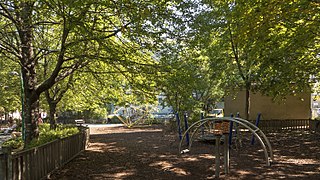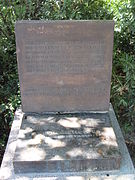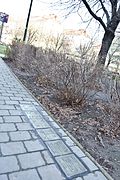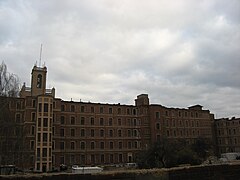Belgrade Square
| Belgrade Square | |
|---|---|
| Place in Vienna | |

|
|
| Basic data | |
| place | Vienna |
| District | Favoriten (10th district) |
| Created | 1900 |
| Confluent streets | Davidgasse , Malborghetgasse, Rotenhofgasse, Bernhardtstalgasse |
| use | |
| User groups | Pedestrians , bicycle traffic , car traffic , bus route 7A |
| Space design | park |
| Technical specifications | |
| Square area | approx. 6580 m² |
The Belgrade court is located in the 10th Vienna district favorites . It was named in 1900 in memory of the conquest of Belgrade in the course of the Turkish wars (1717 by Prince Eugene and 1789 by General Laudon ).
Location and characteristics
Belgradplatz is located between Davidgasse , Malborghetgasse, Rotenhofgasse and Bernhardtstalgasse. Its area is taken up by the Barankapark-Hellerwiese. The area consists of residential buildings from the post-war period, while the south side is dominated by the former Heller chocolate factory. The traffic situation is therefore rather calm, only Davidgasse is a little more frequented by car traffic. The city bus line 7A, which has a stop at Belgradplatz, also runs there.
Remarkable
Barankapark Hellerwiese
This green area was formerly known as Hellerwiese , as the large Heller chocolate factory was south of the meadow. Apart from this factory building, Belgrade Square was not built up and the meadow was used by traveling Lovara , Roma and Sinti as a meeting point, from which they cultivated their trade (horses) in the Graz area. In 1941 they were taken to concentration camps from here. This is reminiscent of the naming of the park in Barankapark after a Lovara formerly known as a natural healer and the setting of a chestnut tree with a memorial stone in the southwest area of the park. There is a pavilion with resting places, while the central meadow, the football cage in the north and the children's playground in the east serve the youth.
In May 2014, six memorial stones were laid in Barankapark, commemorating the numerous members of Roma families who were arrested, deported and murdered by the Nazi regime .
Numbers 3–5 Former Heller chocolate factory
In 1890 the brothers Gustav and Wilhelm Heller founded a chocolate and sugar confectionery factory. Over time, with the brands Wiener Zuckerl and Schokobananen, it became known beyond the country's borders. The company founder Gustav Heller (1857–1937) was an imperial court purveyor, president of the Central Association of Chocolate and Sugar Confectionery Manufacturers, but also a member of the Board of Directors of Creditanstalt . During the National Socialist era, the company was "Aryanized" and the family got it back after the war. In 1971 it was acquired by the company Victor Schmidt & Sons , which integrated the former Heller products into its production and shut down the factory on Belgradplatz. The artist André Heller is a grandson of Wilhelm Heller.
The factory building itself was one of what used to be a large number of plants in Favoriten. It was built from 1898 according to plans by Wilhelm Klingenberg and was expanded several times until 1913/14. It is a brick building with an additive structure, the cornices and window frames of which are plastered. Siegmund Müller then added a residential and commercial building to the factory in 1913/14, with a tower structure and pilaster strips. The whole complex is built around the edge of the courtyard, with the former boiler house and a factory chimney in the courtyard.
After the renovation of the structure of the listed building, it will be used as a nursing home interior favorites for 265 elderly people in need of care from 2011.
literature
- Felix Czeike (Ed.): Belgradplatz. In: Historisches Lexikon Wien . Volume 1, Kremayr & Scheriau, Vienna 1992, ISBN 3-218-00543-4 , p. 314 ( digitized version ).
- Dehio Handbook Vienna. X. to XIX. and XXI. to XXIII. District . Anton Schroll, Vienna 1996
- Peter Autengruber: Parks and Gardens in Vienna . Promedia, Vienna 2008
Web links
Individual evidence
- ↑ Stones of Remembrance: Unveiling of Stones of Remembrance on May 20, 2014 as part of the 6th Baranka Park Memorial Service ( Memento from November 17, 2015 in the Internet Archive )
Coordinates: 48 ° 10 ′ 27.5 ″ N , 16 ° 21 ′ 36.7 ″ E














